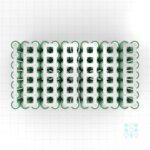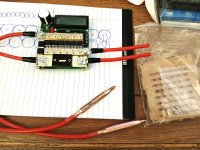You are using an out of date browser. It may not display this or other websites correctly.
You should upgrade or use an alternative browser.
You should upgrade or use an alternative browser.
I guess I need to make 72v 35ah battery pack
- Thread starter Theodore Voltaire
- Start date
Theodore Voltaire
1 GW
I see what you mean. According to the chart 0.15 x 8 is only equivalent to 7g wire. 0.3 is like 14g. 14g seems small for 20 amps? Maybe use 0.3 with 0.15 welded on top?This depends on your pack layout. Perhaps you can draw it, or at least describe it? I just skimmed through the thread quickly, so perhaps you've stated it and I just missed it, but it seems like you're planning a 100a capable pack. Meaning your total series connections need to be able to handle 100a. How many strips of nickel will be in the parallel connections? I couldn't tell for sure from your descriptions in the above posts whether you're planning 7p or 10p.

Nickel Strip ratings
Hi All, I am just wondering if someone can point me to a chart or resource that will show me the current ratings for this: https://eu.nkon.nl/accessories/battery-solder-strip/nikkel-batterijpack-verbinding-soldeerstrip-27mm.html nickel strip 27mm x 0.15m. I have asked Nkon and they don't...endless-sphere.com
If you follow this chart, you'll see that .15x8mm nickel is only good for about 5 amps. To safely carry 100a, you'd need 20. If you're planning 10p, and there's 10 series connection points between all your parallel groups, then it's "possible" to get what you need by stacking 2ea .15x8mm strips per nickel connection. If you're doing 7p, I wouldn't recommend stacking 3 strips.
My welder came today. I'm not sure how thick of metal it can weld. I didn't realize I had to put it all together. It's like a test, if you can't figure it out put your hands up, and back away from the battery box.
Attachments
Theodore Voltaire
1 GW
I'm now thinking of 2 ways of building a 72v pack that would fit my space.
Plan a
7 parallels of groups of 20 cells in series = 72v, 140 cells
or
Plan B
groups of 7 parallel cells, in 20 series, = 72v 140 cells
I'm guessing either method would end up the same, but I'm not sure. Would one way be better then the other?
Plan a
7 parallels of groups of 20 cells in series = 72v, 140 cells
or
Plan B
groups of 7 parallel cells, in 20 series, = 72v 140 cells
I'm guessing either method would end up the same, but I'm not sure. Would one way be better then the other?
docw009
1 MW
I believe that the ideal layout for a battery to stack each group in one column. Then place the groups end to end, so that the series current flows directly from one cell to the next. Here is how it would look for a 13S-7P. Each horizontal section of nickel needs to be thick enough to carry 1/7 of the battery current, The vertical connects are only for small parallel currents, so don't have to be very heavy, At the positive and negative ends of the array, you have to connect the power cables so the current flows evenly out of all 7 cells.

I do not like stacking strips, I think they can be problematic when you do more than two. However, you have a big welder so it shouldn't be a problem.

I do not like stacking strips, I think they can be problematic when you do more than two. However, you have a big welder so it shouldn't be a problem.
Theodore Voltaire
1 GW
I'm finally starting to understand how, and why, to build a pack with more parallel cell groups as opposed to all series cell groups. Apparently building with parallel cell groups in series, instead of single cell groups in parallel you get less sag. I hadn't thought about that before, but it makes sense to me. If I'm wrong about this feel free to say so. Nothing is set in stone.I believe that the ideal layout for a battery to stack each group in one column. Then place the groups end to end, so that the series current flows directly from one cell to the next. Here is how it would look for a 13S-7P. Each horizontal section of nickel needs to be thick enough to carry 1/7 of the battery current, The vertical connects are only for small parallel currents, so don't have to be very heavy, At the positive and negative ends of the array, you have to connect the power cables so the current flows evenly out of all 7 cells.
View attachment 351829
I do not like stacking strips, I think they can be problematic when you do more than two. However, you have a big welder so it shouldn't be a problem.
I'm now thinking in terms of 20 groups of 7 parallel cells each. That still ends up 72v and 140 cells.
Last edited:



